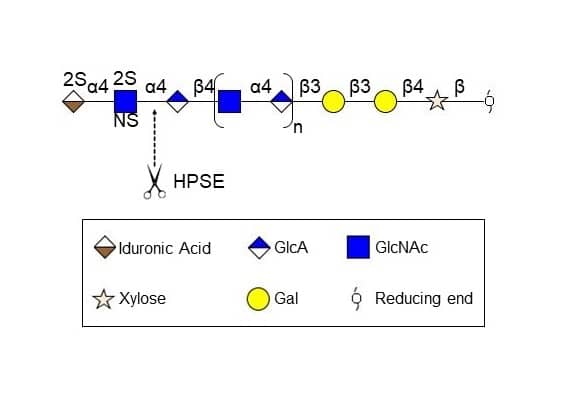Recombinant Human Active Heparanase/HPSE Protein, CF
R&D Systems, part of Bio-Techne | Catalog # 7570-GH

Key Product Details
Learn more about Fluorescent Glycan Labeling and Detection
Product Specifications
Source
Chinese Hamster Ovary cell line, CHO-derived human Heparanase/HPSE protein
Gln36-Ile543 with N-terminal 6-His tag
The linker peptide from Ser110-Gln157 is removed by protease treatment
Gln36-Ile543 with N-terminal 6-His tag
The linker peptide from Ser110-Gln157 is removed by protease treatment
Purity
>95%, by SDS-PAGE visualized with Silver Staining and quantitative densitometry by Coomassie® Blue Staining.
Endotoxin Level
<1.0 EU per 1 μg of the protein by the LAL method.
N-terminal Sequence Analysis
His & K158
Predicted Molecular Mass
43 kDa & 9 kDa
SDS-PAGE
50-60 kDa & 7-9 kDa, reducing conditions
Activity
Measured by its ability to release biotinylated heparan sulfate from Recombinant Human Syndecan-4 (Catalog # 2918-SD).
20 ng of Recombinant Human Active Heparanase/HPSE digestion will result in >50% of OD reduction compared with the Negative Control, as measured under the described conditions.
20 ng of Recombinant Human Active Heparanase/HPSE digestion will result in >50% of OD reduction compared with the Negative Control, as measured under the described conditions.
Scientific Data Images for Recombinant Human Active Heparanase/HPSE Protein, CF
Recombinant Human Active Heparanse/HPSE Protein Enzyme Activity Diagram.
Recombinant Human Active Heparanse/HPSE Protein, CF (Catalog # 7570-GH) selectively cleaves the linkage between a GlcA and an N-sulfo GlcNAc (NS) carrying either a 3-O-sulfo or a 6-O-sulfo group. Can also cleave the linkage between a GlcA and an N-sulfo GlcNAc carrying a 2-O-sulfo group (2S), but not linkages between a GlcA unit and a 2-O-sulfated iduronic acid moiety as depicted in the diagram.Recombinant Human Active Heparanase/HPSE Protein SDS-PAGE.
2 μg/lane of Recombinant Human Active Heparanase/HPSE Protein (Catalog # 7570-GH) was resolved with SDS-PAGE under reducing (R) and non-reducing (NR) conditions and visualized by Coomassie® Blue staining, showing bands at 50-60 kDa & 7-9 kDa under reducing conditions.Formulation, Preparation and Storage
7570-GH
| Formulation | Supplied as a 0.2 μm filtered solution in Tris, NaCl and E64. |
| Shipping | The product is shipped with polar packs. Upon receipt, store it immediately at the temperature recommended below. |
| Stability & Storage | Use a manual defrost freezer and avoid repeated freeze-thaw cycles.
|
Background: Heparanase/HPSE
References
- Vlodavsky, I. et al. (1999) Nat. Med. 5:793.
- Hulett, M.D. et al. (1999) Nat. Med. 5:803.
- Gong, F. et al. (2003) J. Biol. Chem. 278:35152.
- Peterson, S.B. and Liu, J. (2010) J. Biol. Chem. 285:14504.
- Nadav L. et al. (2002) J. Cell Sci. 115:2179.
- Gingis-Velitski, S. et al. (2004) J. Biol. Chem. 279:44084.
- Abboud-Jarrous, G. et al. (2008) J. Biol. Chem. 283:18167.
- Zetser, A. et al. (2004) J. Cell Sci. 117:2249.
- Zcharia E. et al. (2001) J. Mammary Gland Biol. Neoplasia 6:311.
- Fux, L. et al. (2009) Trends Biochem. Sci. 34:511.
- Cohen-Kaplan, V. et al. (2008) Int. J. Cancer 123:2566.
- Purushothaman, A. et al. (2010) Blood 115:2449.
- Nadir, Y. et al. (2010) Haematologica 95:1927.
- Goldshmidt, O. et al. (2003) FASEB J. 17:1015.
- Kussie, P.H. et al. (1999) Biochem. Biophys. Res. Commun. 261:183.
- Wu, Z.L. et al. (2017) Glycobiology 27:518.
Alternate Names
Endo-glucoronidase, HPA1, HPR1, HPSE, HSE1
Gene Symbol
HPSE
UniProt
Additional Heparanase/HPSE Products
Product Documents for Recombinant Human Active Heparanase/HPSE Protein, CF
Product Specific Notices for Recombinant Human Active Heparanase/HPSE Protein, CF
For research use only
